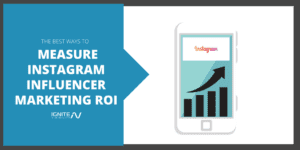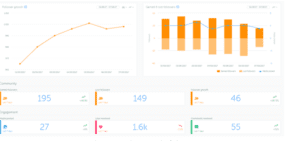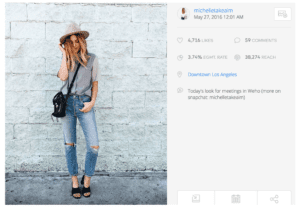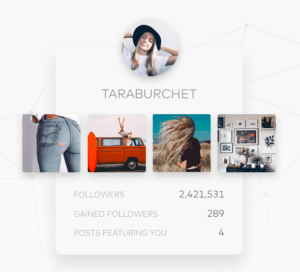Everyone wants to do influencer marketing. But no one knows how to really measure the results!
In this blog, I’ll teach you how to measure Instagram influencer marketing ROI.

The Best Ways to Measure Instagram Influencer Marketing ROI
Influencer Marketing Breakdown
As social media and its ensuing platforms have gained continuous popularity, they’ve given rise to a new type of celebrity: the social media influencer.
These influencers mimic your traditional celebrity in that their fans genuinely care about what they do and say. They also have the added appeal of not being an actual celebrity, making them more relatable and ultimately more human.
Which means their followers listen to them. They hang on their product recommendations and tutorials. If their favorite influencer is using it, they want to use it too.
And the facts back it up.
- 74% of people turn to social networks for guidance on purchase decisions.
- 49% of people say they rely on recommendations from influencers when making purchase decisions.
- 40% of people say they’ve purchased an item online after seeing it used by an influencer on Instagram, Twitter, Vine, or YouTube.

Measure Instagram Influencer Marketing
Instagram, in particular, has emerged as a leading popular for influencers, due in part to its photo-driven nature.
In fact, marketers who use Instagram for influencer marketing see on average an ROI of 11x higher than other digital tactics.
It’s a tactic that required researching, planning, and proper execution. When done well, it can work absolute wonders.
Make sure yours is working well by using the following methods to track your ROI.
Instagram Influencer Marketing: Setting Goals
The success of your campaign all comes down to the goals you set.
Without knowing what exactly it is you’re trying to accomplish, there’s no way you can properly assess the outcome.
So before you go about finding influencers and forming a strategy, put some due diligence into outlining what you want to get out of your campaign.
To be clear, I’m talking concrete, well-defined and detailed goals.
Consider the following:
- I want more sales.
- I want an extra $2,000 in sales per week.
Or:
- I want more Instagram followers.
- I want to increase my followers by 150 each week.
There’s a clear winner here when it comes to good goal setting (spoiler alert: it’s the second one.)
Depending on which goal you choose, the way you measure ROI will differ completely, which is why it’s so important to have real numbers and outcomes you’re looking for.
Measure Instagram Influencer Marketing Costs
It goes without saying that in order to calculate your return on investment, you first need to know what your total investment is in the first place.
So pull out the calculator and do a little math, and really look at the full picture.
Include any costs related to labor from you or a team member – researching influencers, reaching out, strategizing, etc. Include any product samples or content production costs regarding images or other multimedia you may send an influencer for promotion.
If you’re using a tool like Activate, Reward Style or Adly to help connect you with influencers, those costs should be included as well.
And of course, tally up the cost of the actual influencer.
Once you put all of the above together, you’ll have a better idea of the results you need to justify the costs.
How to Measure Your Instagram Influencer Marketing ROI
Measuring social media’s overall ROI has never been straightforward.
There are many different factors to look at, and each is dependent on the goals you set.
Beyond that, unless you’re going explicitly for monetary gain, it can be difficult to decide what a desirable ROI is for your business.
But there are a few ways to make the process a little simpler.
Ways like:
- Using a trackable link – applying a UTM tracking code to the content your influencer posts will allow you to easily track how where your traffic is coming in, and how much can be attributed to your influencer campaign
- Provide a promo code – if you’re using your campaign to push more sales, providing your influencer with a promo code is a great way to track how many people the campaign is actually reaching. Not only that, but a promo is always an easy way to entice potential customers to make the purchase
- Create a hashtag campaign – if staged correctly, you can use your influencer partnership to push a hashtag campaign, and track how many uses the hashtag gets. It makes sense that you could attribute many of those uses to the influencer campaign
- Track Traffic Correlations – notice a spike in traffic or search queries after an influencer post? That probably means it’s working.
Outside of the above tactics, there are a few key metrics that will help indicate your overall ROI.
Follower Growth
If your goals have to do with increased reach, exposure or brand awareness, this is a number to keep an eye on.
Because influencers appeal to highly targeted, niche audiences, it can be extremely effective to use them to appeal directly to the audience you’re trying to reach. That way, you can use their posts to send traffic back to your account.

Instagram Influencer Marketing ROI: Track Follower Growth With Tools Like Iconosquare
Starting out, have a percentage in mind that you would like to reach. It could be a 10% or a 50% increase, over as long a time period as you plan to run the campaign.
Of course, to truly determine ROI, you have to first determine how much each follower is worth to you. This could be based on customer lifetime value, savings on additional advertising, or the social proof of having a large follower base.
Instagram Influencer ROI: Engagement Rate
This is generally measured in cost-per-engagement (CPE), which is the dollar amount spent for each like, comment, share, etc.
Engagement rate is generally a long-term investment. While it may not have an immediate monetary value, it can lead to a stronger fan – and eventually customer – base in the long term.
Engagement is a good predictor of future growth but it indicated followers feel about a brand, not just a specific product. Those that interact and engage on social media with a brand are more likely to stay loyal.
This is also an important metric to pay attention to when selecting your influencers. Those with large followings but few interactions and engagements won’t have the same effect as those with an active audience.
Look at the kinds of engagements their posts typically get and set a benchmark for your own campaign.

Instagram Influencer Marketing ROI: Engagement Rate
As you launch your campaign, keep track of the total engagement as well as the engagement rate of each individual post. This will tell you how well your content is resonating with an influencer’s audience overall, as well as the specific kinds of content that work best.
Also consider this: Instagram and parent company Facebook are notorious for their algorithm updates, which significantly favor accounts with high engagement rates.
If you see an improvement in yours, that could, in turn, lead to increased exposure for your account as Instagram gives your posts a boost in the rankings.
Something to consider when determining how it fits into your overall ROI.
Instagram Influencer ROI: Website or Landing Page Traffic
Another common goal is to increase the amount of traffic to a brand’s website or a specific page.
It could be for a variety of reasons – maybe you want more blog traffic, are promoting a webinar or event registration, or unveiling a new product or service.
This is particularly common for more industries like news, publishing, marketing, etc., whose goal isn’t necessarily to sell something but instead to increase readers.
If that’s the case, your campaign will likely be providing influencer’s links to your content and can measure ROI by the number of viewers who visit the page (UTM tracking will come in handy here).
This tactic will also require you to set a value for the number of visitors since you won’t be measuring your ROI based on direct monetary gain.
If you are sending traffic to your site for an action to be completed, such as a signing up for an event or downloading a white paper, you would measure your ROI in terms of form submission or registration.
Both of these methods rely on a reliable way of tracking where your site visitors come from, so do look into tracking codes that will give you an accurate read of how much an influencer contributes to your goal.
Increased Sales, Subscriptions, Etc.
This is the one everyone wants.
An increase in sales is an undeniable sign that your influencer marketing campaign is paying off. It’s also the easiest to track in terms of ROI.
But keep in mind, the buying cycle will vary depending on what you’re selling, and it may take some time to see results.
Brands in the lifestyle industry – beauty, fashion, etc. – that can offer influencers product demos (and often include shoppable links) will likely have the most immediate results here.
Other services may take longer to see a noticeable increase, which is why it’s important to keep track of your results after you’ve finished your influencer marketing campaign.
Tools to Measure Instagram Influencer Marketing ROI
This might seem like a lot.
And if you were tracking this all on your own, it absolutely would be.
Luckily, there are tools to help.
One of my favorite newer tools is Dash Hudson. It’s a complete Instagram tool for scheduling posts and growing your account, and also comes with in-depth reporting to measure your influencer marketing ROI.

Instagram Influencer Marketing ROI: Dash Hudson Tool
Dash Hudson will deliver real-time results regarding the engagement rates of your influencer posts, audience growth, and which content is driving the most impact.
Read our full review of the tool here.
But you’re not limited in the influencer arena. Some tools, like the popular Klear or Onalytica, don’t cater exclusively to Instagram but will help you identify the best influencers for your biz and track the ROI of your campaign.
Influencer Marketing ROI FAQs
How to Measure Influencer Marketing Success
There are a few key performance indicators that will help you with how to measure influencer marketing success.
You can keep track of traffic data that an influencer drives to your site, the amount of followers your influencer has, and the number of times your brand is exposed to your target audience as a direct result of an influencer.
You can take the process a step further by keeping track of clicks, likes, reactions, comments, brand mentions, and shares which an influencer directly leads to.
Using Google Analytics you can also collect data regarding target audience growth and quantify social leads.
Lastly, you can analyze the origin of sales to make sure your influencer is directly causing conversions to occur.
What is the ROI of Influencer Marketing?
Influencer marketing can be a great investment for your business:
If your main demographic includes teens or women this may be a great venue as 70% if teens trust influencers and 86% of women use social media for advice on what to purchase.
Close to half (49%) of consumers rely on recommendations from influencers and influencer marketing is gaining traction and speed in helping business sell products and services.
The most astonishing case for the ROI of influencer marketing campaigns is that they earn $6.50 for every dollar spent.
If you haven’t considered influencer marketing yet it is certainly worth a try.
Wrapping Up Instagram Influencer Marketing ROI
As with any marketing plan, a clear strategy for measuring and tracking ROI is essential when it comes to influencer marketing.
Remember, your individual ROI will be directly tied to the goals you set, so be clear about what you need out of this campaign.
While you’ll undoubtedly gain a broader reach through influencers, for many brands, reach alone isn’t enough.
So be clear. Stay consistent. And most importantly, get started.